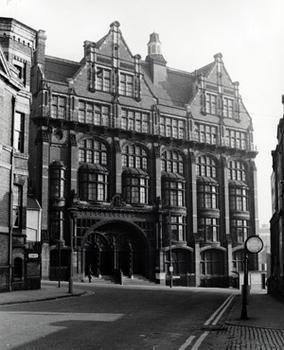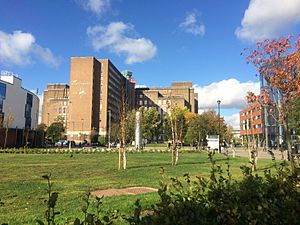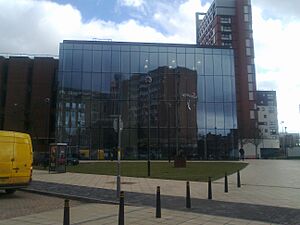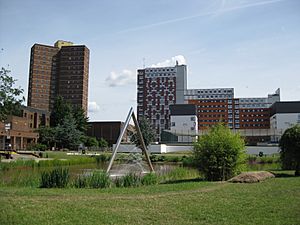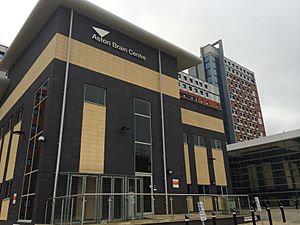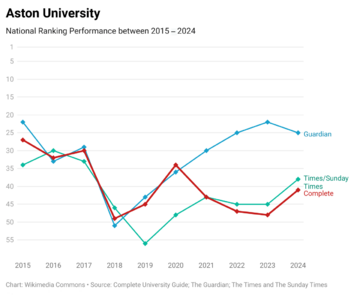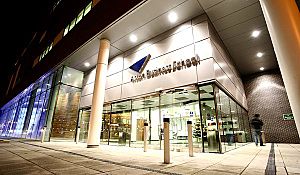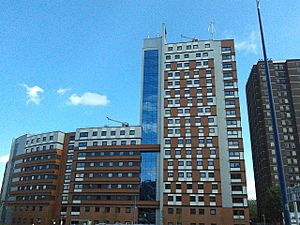Aston University facts for kids

|
|
|
Other name
|
Aston University of Aston |
|---|---|
| Motto | Forward |
| Type | Public |
| Established | 1895 – The Birmingham Municipal Technical School 1927 – Birmingham Central Technical College 1951 – College of Technology, Birmingham 1966 – gained university status by royal charter |
| Endowment | £1.47 million (2022) |
| Budget | £197.7 million (2021–22) |
| Chancellor | Jason Wouhra |
| Vice-Chancellor | Aleks Subic |
| Students | 15,500 (2017–18) |
| Undergraduates | 11,935 (2017–18) |
| Postgraduates | 3,565 (2017–18) |
| Location |
,
England, United Kingdom
52°29′10″N 1°53′22″W / 52.4860°N 1.8895°W |
| Campus | Urban 60 acres (24 hectares) |
| Colours | White and Pink/Purple |
| Affiliations |
|
 |
|
Aston University is a public university located in the city of Birmingham, England. It started as the Birmingham Municipal Technical School in 1895. Over time, it became the UK's first special "college of advanced technology" in 1956. Aston University officially became a university when Queen Elizabeth II granted it a royal charter on April 22, 1966.
Aston was one of the first universities to offer a "placement year." This means students spend a year working in a real job as part of their studies. More than 73% of Aston students take a placement year, which is one of the highest numbers in the UK.
Aston University has won several awards. In 2020, The Guardian newspaper named it "University of the Year." The Times Higher Education Awards also recognized Aston as an "Outstanding Entrepreneurial University" in 2020. In March 2024, Aston University received the Athena SWAN Gold Award. This award recognizes its efforts to promote fairness between genders.
Contents
History of Aston University
How Aston University Started
Aston University began as a School of Metallurgy in 1875. This school was part of the Birmingham and Midland Institute. In 1895, it became the Birmingham Municipal Technical School. It taught subjects like chemistry, physics, and engineering. By 1917, it also taught botany to future teachers. In 1927, the school changed its name to the Birmingham Central Technical College. This new name showed its focus on technology.
In 1951, the college was renamed the College of Technology, Birmingham. Work started on its main building at Gosta Green. In 1956, it became the first "college of advanced technology." This meant it was a top place for technology studies. The college moved into new buildings built between 1949 and 1955. Princess Margaret helped lay one of the first foundation stones in 1951. The main building is one of Europe's largest brick buildings. In 1955, Queen Elizabeth II officially opened the College of Advanced Technology.
Becoming a University
The college officially became the University of Aston in Birmingham on April 22, 1966. This happened when it received its royal charter. The first leader of the university, Lord Nelson of Stafford, started his role on May 10, 1966. The university's main goal is to share knowledge through teaching and research. It aims to help businesses and the community. The university also wants students to get a good education. This includes time spent working in companies. The university's motto is Forward, which is the same as the City of Birmingham's motto.
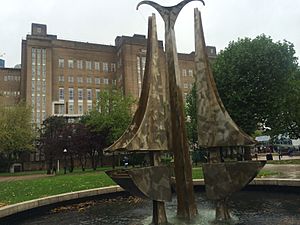
In 1983, Aston University helped create the Aston Science Park. This park is next to the university and helps new technology companies grow. Because of Aston University's importance to Birmingham, the area around the campus was given its own postal address, "The Aston Triangle," in 1984. The university's logo is shaped like this area.
Recent History (2000 to Present)
Aston University hosted the British Science Festival in September 2010. This was Europe's largest public science event.
Since May 2011, Sir John Sunderland has been the Chancellor of Aston University.
The university also supports the Aston University Engineering Academy. This is a special college for students aged 14 to 19 who want to study engineering. It opened in September 2012 and is located near the Aston University campus.
In October 2014, Aston announced plans to open Aston Medical School in October 2015. The university also invested £35 million to improve its campus. This included a new £19 million update for Aston Business School.
In February 2017, Aston University started offering some of its Master's degree programs completely online. This allows students from the UK and around the world to study from home.
In July 2017, Aston was the first UK university to have graduates from "degree apprenticeships." These programs combine university study with on-the-job training.
In 2021, the university planned to close its History and Languages departments. This decision caused protests from students and teachers. Many people, including important figures, spoke out against it. Because of this, the university decided to keep the History program. However, some language courses were still reduced.
In 2024, plans were submitted to change the main building. The idea is to remove part of the south wing. This will create more green space and walking paths. It will also bring back the original look of the main entrance.
Aston University Campus
Aston University is located on a 60-acre campus in Gosta Green, in the center of Birmingham. The campus is home to over 3,000 students. It has many facilities like sports centers, a swimming pool, a gym, a library, cafes, restaurants, shops, and a health center. There are also places of worship, a dentist, and ATMs.
The Aston University Library has four floors. It holds over 250,000 books and many online resources. The library is open 24 hours a day during exam times for students and staff. During term time, it is open about 12 hours a day.
There are also computer rooms around campus. These rooms offer computer and internet access 24 hours a day, seven days a week.
Sports at Aston
Aston's sports facilities include a 25-meter swimming pool, a sauna, and two sports halls. There is also a large gym, dance studios, and 35 sports clubs. The campus has two outdoor sports pitches with lights. Many clubs train and compete in the British Universities and Colleges Sports (BUCS) Leagues. The university also has a large sports ground off campus for outdoor sports.
How Aston University is Organized
In 2020, Aston University changed how its schools are organized. It now has three main colleges:
College of Business and Social Sciences
- Aston Business School
* Accounting * Economics, Finance, and Entrepreneurship * Marketing and Strategy * Operations and Information Management * Work and Organisation
- Aston Law School
- School of Social Sciences and Humanities
* English, Languages and Applied Linguistics * Sociology and Policy * Politics, History and International Relations
College of Engineering and Physical Sciences
- School of Computer Science and Digital Technologies
* Electrical and Computer Engineering * Mathematics and Data Science * Computer Science and Cybersecurity * AI and Robotics
- School of Engineering and Technology
* Mechanical Engineering and Design * Biomedical Engineering * Aston Foundation Centre * Aston Professional Engineering Centre
- School of Infrastructure and Sustainable Engineering
* Chemical Engineering and Applied Chemistry * Engineering Systems and Supply Chain Management * Civil Engineering
College of Health and Life Sciences
- School of Biosciences
- Aston Medical School
- School of Optometry
- Audiology and Healthcare Sciences
- Aston Pharmacy School
- Neuroscience
- School of Psychology
University Coat of Arms
The university's coat of arms was given in 1955. It shows the college's connection to the city of Birmingham and to technology. The shield has a blue background with five gold diamonds. These diamonds are similar to those on Birmingham's city arms. This shows the link to the city. On the top part of the shield, there is an open book between two black hammers. The book means learning, and the hammers represent engineering.
The crest above the shield also shows the search for knowledge. It has a red torch held by an arm, surrounded by laurel branches. The crest is joined to the helm (a helmet shape) with a wreath and a crown. The crown looks like a wall and is used for organizations connected to public groups.
In 2016, for the university's 50th anniversary, two animals were added to support the arms: a Canada goose and a red squirrel. The Canada goose represents the geese living on campus. The squirrel is from the arms of Aston Manor and is a play on words related to the old owners of Aston Manor. The gorse plant around the animals' necks refers to Gosta Green, where the university is located.
Academic Dress
Students wear special robes, hoods, and hats for graduation ceremonies. The style and color of these clothes depend on the degree they have earned. For example, Bachelor's and Master's degrees have black gowns and hoods. Doctoral degrees have claret (dark red) gowns.
Academic Information
University Rankings
| National rankings | |
|---|---|
| Complete (2021) | 44 |
| Guardian (2021) | 21 |
| Times / Sunday Times (2021) | 35 |
| Global rankings | |
| ARWU (2020) | 701–800 |
| QS (2021) |
395= |
| THE (2021) | 351–400 |
| British Government assessment | |
| Teaching Excellence Framework | Gold |
Aston University is often ranked highly among UK universities. In The Guardian University Guide 2022, it was in the top 25.
The UK government's 2023 Teaching Excellence Framework gave Aston University an overall Gold rating. This rating looks at teaching quality, learning environment, and how well students do after graduation.
Aston is known for its strong student outcomes. For example, in The Guardian University Guide 2021, Aston was 11th in the UK for "Continuation." This means a high number of students continue their studies after their first year. It was also joint 24th for "Value Added," which compares student grades to what was expected.
The Times/Sunday Times Good University Guide 2021 ranked Aston 31st in the UK for students getting high degree classifications (1st or 2:1). It also ranked Aston 30th for "Graduate Prospects." This measures how many graduates get professional jobs or continue their studies within 15 months.
A study in 2020 found that Aston graduates had the 15th highest average salary among all UK universities five years after graduating.
Research at Aston
In the 2021 Research Excellence Framework, which checks the quality of research in UK universities, Aston was ranked joint 58th. This shows the strength of its research. In 2008, 88% of Aston's academic staff submitted their research for review. The university is strong in areas like Business and Management, Engineering, Health Sciences (like Optometry and Pharmacy), and Languages.
Admissions Information
|
New students joining Aston University in 2020 had an average of 133 points. This is like getting grades of ABB or AAB in A-Levels. About 3% of Aston's undergraduate students come from independent schools.
Aston Business School
Aston Business School (ABS) was founded in 1947. It is one of the largest and oldest business schools in the UK. In 2012, QS World University Rankings placed it 8th in the UK and 33rd in the world. It is also among the top 60 business schools globally to have "triple accreditation." This means it meets high standards from three different organizations. ABS was the first UK business school to get the EQUIS accreditation in 1999.
Aston University is in the top 100 worldwide for Business and Management in the 2020 QS World Subject Rankings. It is also in the top 200 for Accounting and Finance.
In 2012, the Financial Times ranked the business school's Masters Management course as 5th in the UK and 36th in the world. The paper also said Aston Business School was 4th in the world for careers in 2011.
Aston is ranked 2nd in the UK for training marketing professionals and 7th for finance professionals. This is based on career data from LinkedIn. It is also 23rd in the UK for accounting professionals.
Student Life at Aston
Aston Students' Union
The Aston Students' Union (SU) is a non-profit group that helps and represents students at Aston University. The SU offers many services, including advice, support for sports clubs, and support for other student groups. It also runs a shop, a copy shop, and a bar. The SU is led by elected students and staff.
In November 2006, students voted to leave the National Union of Students. However, they voted to rejoin in November 2014.
Student Housing
All of Aston University's student housing was sold to UNITE Students in 2016. In the 1970s, three tall buildings called Dalton, Lawrence, and Stafford Towers were built for student housing. In 2007, the university planned to knock down these towers and build new student homes. Lawrence and Dalton Towers were taken down in May 2011. Stafford Tower was taken down in April 2014. This made space for a new entrance to the university and a large green area. The new student buildings are named the William Murdoch, the James Watt, the Harriet Martineau, and the Mary Sturge Residences.
The Lakeside complex on campus was finished in August 1999. This also provides student housing.
Notable People from Aston University
Chancellors of Aston University
- Lord Nelson of Stafford (1966 – 1979)
- Sir Adrian Cadbury (1979 – 2004)
- Michael Bett (2004 – 2011)
- John Sunderland (2011 - 2024)
- Dr Jason Wouhra (since June 2024)
Vice-Chancellors of Aston University
- Peter Venables (academic administrator) (1966 – 1969)
- Sir Joseph Pope (1969 – 1979)
- Sir Frederick W. Crawford (1980 – 1996)
- Michael T. Wright (1996 – 2006)
- Dame Julia King (2006 – 2016)
- Alec Cameron (2016 – 2021)
- Aleks Subic (August 2022 – present)
Famous Alumni
Academia and Science
- Andrew Campbell, computer scientist
- Stewart Clegg, Australian sociologist
- Paul Drayson, Baron Drayson, vaccine maker and former government minister
- Veronica German, scientist and politician
- Abdollah Jassbi, President of Azad University
- Rahul Potluri, doctor and researcher
- Adam Ryland, British programmer
- Kevin Warwick, Professor of cybernetics
- Steve Wharton, British academic
- David Willey, American physicist
Arts and Media
- Frankie Boyle, comedian and TV presenter
- Laura Jones, BBC journalist
- Ivan Noble, BBC journalist
- Nic Robertson, Senior International Correspondent at CNN
- Kate Walsh, television presenter
Business Leaders
- Viswas Raghavan, CEO of J.P. Morgan EMEA
- Ben Francis, Founder of Gymshark
- Adel Hassan Al A'ali, CEO of Hajj Hassan Group
- Chris Banks, British businessman
- Tony Hayward, Former chief executive of BP Group
- Ravi Kant, Vice Chairman of TATA Motors, India
- Kevin Morley, Former Managing Director of the Rover Group
- Rob Perrins, Managing Director of Berkeley Group Holdings
- Phil Popham, Global Operations Director for Jaguar Land Rover
- Sir Arthur Smout, former managing director of Imperial Chemical Industries
Politicians
- Keith Bradley, Baron Bradley, Labour Party politician
- Anthony Cheung, former government official in Hong Kong
- Simon D'Ujanga, State Minister for Energy in Uganda
- Malcolm Harbour, British politician
- Mohammad Nizar Jamaluddin, Former Chief Minister of the state of Perak
- Ashok Kumar, Labour Party politician
- Rachel Maclean, Conservative Party politician
- Terry Pitt, political adviser
- Jeff Rooker, Baron Rooker, Labour Party politician
- Claire Curtis-Thomas, British Labour Party politician
- Robert Walter, Conservative politician
- Salma Yaqoob, Leader of Respect – The Unity Coalition
Sports Figures
- Rūta Bunkutė, fitness and figure competitor
- Gregor Townsend, Scottish and British Lions Rugby Union Player
Other Notable People
- Ernest Henry Wilson, famous plant collector
- Rick Stanton, cave diver
See also
 In Spanish: Universidad de Aston para niños
In Spanish: Universidad de Aston para niños
- Armorial of UK universities
- College of advanced technology (United Kingdom)
- List of universities in the United Kingdom


